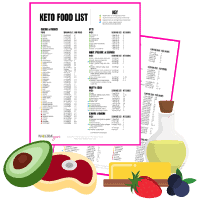
Free Printable: Low Carb & Keto Food List
Get It Now- What Is A Low Carb Diet Plan?
- What Is The Keto Diet?
- Keto Diet Rules: How To Start Keto
- Get The Printable Keto Cheat Sheet System
- Understanding & Counting Macros
- What To Eat On A Keto Diet
- Low Carb & Keto Recipes
- Keto Meal Plans
- Keto Diet Benefits
- Keto Diet Side Effects
- Common Questions
- Conclusion: Is The Keto Diet For You?
- Recipe Reviews
Welcome to the ultimate guide to the keto diet plan, a form of low carb diet. If you are new to Wholesome Yum, or just starting out with this lifestyle, you’ve come to the right place. This guide will show you everything you need to know about how to start a keto diet, including keto diet basics, how to understand and calculate macros, what foods to eat, recipes to make, how to avoid side effects, and more. Be sure to check out all the keto diet recipes and the keto diet app, too!
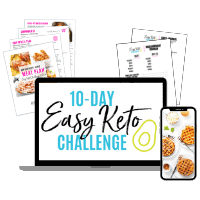
JOIN THE EASY KETO CHALLENGE!
Join 300,000+ others to get this free guide to kickstart keto (everything you need to know, broken up into 10 doable days!) and get support.
JOIN THE CHALLENGEWhat Is A Low Carb Diet Plan?
A low carb diet plan is a way of eating that is high in fat, moderate in protein and low in carbohydrates. It ends the rollercoaster of blood sugar spikes and crashes, allowing the body to burn fat.
There are different variations of low carbohydrate diets. The keto diet plan is a special type of low carb diet, with added characteristics. Optimal carb intake will vary depending on your insulin tolerance and activity level, but on average, these are the common numbers of carbs:
- Keto diet – Under 20g net carbs per day (sometimes under 25g or 30g works)
- Low carb diet – Under 50g net carbs per day
- Moderate low carb diet – Under 100g net carbs per day
Some people opt to count carbs diligently and some choose to simply focus on eat low carb or keto foods. For comparison, according to the Dietary Guidelines For Americans, a Standard American diet contains between 225 and 325 grams of carbohydrates per day.
What Is The Keto Diet?
The ketogenic diet, or keto diet plan, is a specific type of low carb diet that is focused on a specific ratio of macronutrients (or macros for short — these include fat, protein, and carbohydrates), with a goal of reaching a state called ketosis.
There are different ways to follow this diet, including clean keto (focusing on whole foods and nutrients), dirty keto, and lazy keto, among others, but ketosis is the goal with all of them. The keto diet basics below apply to all of them, as well.
What Is Ketosis?
Ketosis is a metabolic state in which the body burns fat for fuel instead of carbs. It’s very effective for weight loss, energy, and mental clarity [*, *, *, *]. The body enters a ketogenic state when carbs are restricted for extended periods, through a low carb diet, fasting [*], or starvation [*].
How Does The Keto Diet Work?
Unlike a low carb diet, ketosis is the primary goal of the keto diet plan. We achieve it by severely limiting carbohydrate intake, not necessarily calories, though calories are often restricted as a byproduct.
The core of how the keto diet works boils down to two things:
- In the absence of carbohydrates, the body switches to burning fat for fuel instead of glucose. When carbs are restricted and your body runs out of glucose, your body turns to fat in food and fat stores for fuel instead. Your livers breaks down the fat into ketones, small energy molecules that your body can use for energy [*].
- A ketogenic diet keeps insulin levels low. Insulin is a signal for your body to hold onto its fat stores, so low levels help your body access its fat stores for energy [*]. This regulates your blood sugar levels as well.
Signs of ketosis include increased energy and focus, decreased appetite, and changes in smell of breath or urine. You can test yourself for ketosis using ketone test strips (use code WHOLESOME for 15% off!). A blood monitor is the most accurate, but not usually necessary if you follow the keto diet rules.
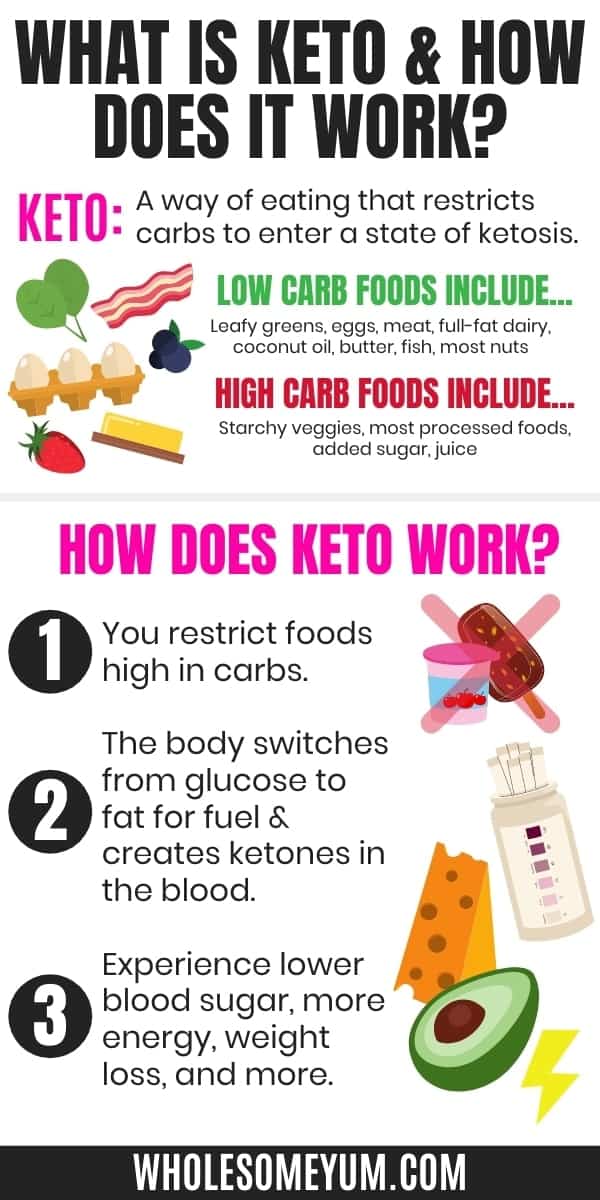
Keto Diet Rules: How To Start Keto
If you want to start a keto diet or low carb diet plan, it can be intimidating. I get it! I’ve been doing this for almost a decade (and it goes to show this is a sustainable lifestyle!), but it wasn’t always easy. We all have to start somewhere. Just start — you got this!
Whether you’re looking for how to start a keto diet or a low carb diet, there are lots of similarities. Let’s make it as easy as possible…
Easy Steps For Starting A Keto Diet
The main point to remember when starting a keto diet is this:
RULE #1: Restrict Carbohydrates. This is the most crucial part! Restrict to less than 20g or 25g net carbs per day for a keto diet plan (some people can get away with under 30g).
For a low carb diet, aim for under 50g net carbs per day. Some variations limit to somewhere between 50-100g per day, particularly if you are more active.
Stay below your carb limit and you’re most of the way there! But to ensure your success, here are some additional tips for getting started on a keto diet — and the same applies for a low carb diet as well:
- Limit protein intake. Contrary to popular belief, keto diets and low carb diets are not high protein diets! Low carb is generally higher in protein than keto, but be careful with both. High protein diets can stress the kidneys, and besides, excess protein converts to glucose. Make your protein intake a goal to meet each day, but more than that is not better.
- Use fat as a lever. We’ve been taught to fear fat, but don’t! Both keto and low carb are forms of a high-fat diet. Fat is our source of energy as well as satiety. The key to understand, though, is that fat is a lever on a low carb or keto diet. Carbs and protein stay constant, and fat is the one you increase or decrease (push the lever up or down) to gain or lose weight, respectively. So if your goal is weight loss, eat enough fat to be satisfied, but there’s no need to “get your fats in” once you’re satisfied.
- Drink lots of water. This is especially crucial on a low carb or keto diet. Why? When you eat carbs, your body stores the extra as glycogen in the liver, where they are bound to water molecules. Eating low carb depletes this glycogen, which allows you to burn fat. But it also means you are storing less water, making it easier to get dehydrated. Instead of the traditional recommendation of 8 cups of water per day, aim for 16 cups when following a low carb lifestyle.
- Keep up electrolytes. The major electrolytes in our bodies are sodium, potassium and magnesium. It’s crucial to get enough of these so that you don’t experience these side effects — they are temporary, but avoidable. Read more about side effects and their remedies below.
- Eat only when you are hungry. Get out of the mindset that you need to eat 4-6 meals per day or constantly snack. Eating too frequently on a keto or low carb diet is not necessary, and can affect weight loss. Eat when you’re hungry, but if you aren’t, don’t. Eating fewer carbs will make this much easier, as this naturally suppresses appetite.
- Focus on whole foods. Although eating natural or whole foods is technically not 100% required to restrict carbohydrates, eating processed foods will not help you get rid of cravings or be good for your body. Check the section below for more on what low carb foods are best.
- Exercise. This is not required for a low carb diet, but recommended. You’ll feel better, improve your health, and if your goal is weight loss, it will happen faster!
Keto Diet Tips For Beginners
The steps above are the most important, but to set yourself up for success, read over these keto diet tips for beginners, too.
Get The Printable Keto Cheat Sheet System
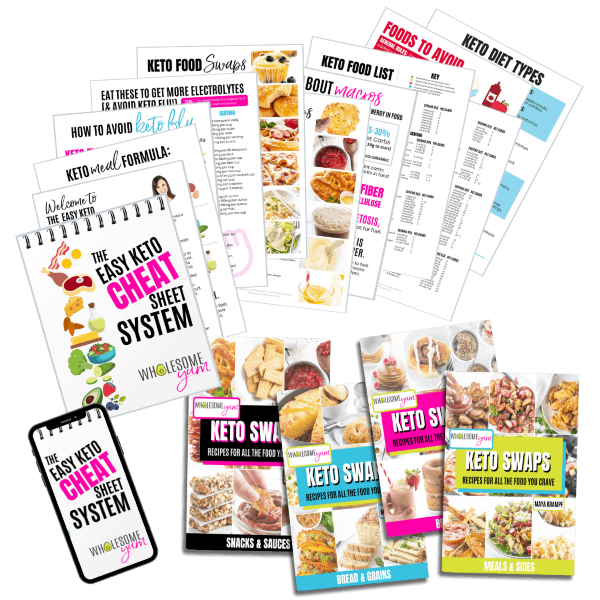
Get all this information and MORE in convenient printer-friendly format - 13 cheat sheet pages you can take with you anywhere or keep in your kitchen, plus 4 recipe cookbooks! Includes:
- Keto food list (230+ foods) - Super detailed & color-coded, with net carb counts, so you'll know exactly what to eat.
- Foods to avoid on keto - Detailed and specific list so that you know exactly what to watch out for.
- Macros cheat sheet - Explains everything you need to know about macros to succeed on keto.
- Keto food swaps (60+ foods) - Covers virtually every food you love, so you don't have to miss out!
- Keto meal formula - With specific food ideas, so it's easy to mix-and-match.
- Keto flu guide - Understand what it is and exactly how to avoid it.
- Electrolyte cheat sheet - With whole food ideas + bonus keto tips.
- Keto Diet Types - Summary of 4 ways to do keto, so you can choose what fits you best.
- FOUR (4!) Keto Swaps Recipe EBooks - Dozens of recipes to replace bread, rice, potatoes, pasta, desserts, and other carbs you'd otherwise miss.
Get The Printable Keto Cheat Sheet System + 4 EBooks (Only $37)
Understanding & Counting Macros
What are macros? Simply put, “macros” is a shortened name for macronutrients, which provide energy and come in the form of fat, protein, and carbohydrates.
All three play a role in a successful keto diet plan:
- Fat – Fat acts as the primary fuel source on a keto diet, unlike a standard diet where carbohydrates are the main source. Your are in ketosis when your body has made the metabolic switch to using fat for most of its energy. In addition, it keeps you satisfied. Just keep in mind that you burn the fat from your food before burning body fat, so use fat as a lever to lose weight, maintain, or gain muscle depending on your goals. Aside from energy, fat plays an important role in metabolism, immune function, reproduction, and absorption of vitamins [*].
- Protein – Proteins are made up of amino acids, which are commonly referred to as the building blocks in our bodies. Proteins are crucial for the structure, function, and regulation of tissues and organs, including antibodies, enzymes, messengers, structural support for cells, transport, and muscle preservation [*]. On a ketogenic diet, you want to get enough protein to support all these functions. However, if you get too much protein, the excess will be converted into glucose by the body — this process is called gluconeogenesis and we want to keep it to a minimum.
- Carbohydrates – Carbs are the most crucial piece of the puzzle. In fact, restricting carbohydrate intake is technically the only thing necessary to enter a state of ketosis. While it’s commonly cited that the brain needs glucose to function, the brain is able to get most of its needed energy from ketones and the liver can make up the rest via gluconeogenesis [*, *]. When we talk about low carbohydrate intake on a keto diet, we usually refer to net carbs, explained below.
As a general guideline, below are the recommended macro percentages to aim for. These are the percentages of your total calorie intake that would be from fat, protein, and carbs.
Macros For A Low Carb Diet Plan:
- Fat: 40% to 70%
- Protein: 15 to 30%
- Net Carbs: 15% to 30%
Macros For A Keto Diet Plan:
- Fat: 60% to 75%
- Protein: 20% to 25%
- Net Carbs: 5% to 10%
You can learn more about how macros work here.
What Are Net Carbs?
Net carbs are the carbohydrates that your body is able to digest and break down into glucose for energy.
The carbohydrates in fiber and non-digestible keto sweeteners, like erythritol and allulose, have zero net carbohydrates, because we are not able to extract that energy. (Read more about sugar substitutes here and you can use the sweetener conversion chart to swap sweeteners.)
TIP: To determine net carbs in any food, subtract the fiber, sugar alcohols (like erythritol), and allulose from the total carbs. Make it easy by using the net carb calculator, where you can also learn more about how net carbs work.
Should You Count Total Carbs Or Net Carbs?
Some people following a ketogenic diet choose to count total carbs instead of net carbs. Some of the reasoning is that technically, soluble fiber is partially digestible, but not usually differentiated from insoluble fiber on labels. Also, some people find that their body does digest a small amount of the carbs from sweeteners, so they feel better counting them.
Unfortunately, counting total carbs makes it more difficult to fit in enough leafy greens and keto vegetables in your low carb diet. These are packed with fiber and beneficial nutrients, so you should only try that if you don’t get results with a net carb method. Also, start with reducing sweeteners and low carb treats before deciding to limit your grams of carbs to only total carbs.
Do You Have To Count Macros?
When you start a ketogenic diet plan, it’s recommended that you count macros at least in the beginning. That way, you’ll get a sense of what and how much you should be eating. However, some people have success simply sticking to low carb foods and not counting anything, while others only count net carbs, but don’t count fat and protein (this method is called lazy keto).
How To Calculate Your Macros
If you really want to be sure that you are eating the right amounts, you need a low carb or keto macro calculator. Most calculators work for just one or the other, but the Wholesome Yum macro calculator will do it for each diet type. It will tailor the results to your body and your goals:
What To Eat On A Keto Diet
One of the most common questions I get is, “what to eat on a keto diet?” or “what to eat on a low carb diet?” Fortunately, with the right resources, this is one of the easiest questions to answer.
In fact, the keto diet plan is probably the most flexible, sustainable eating lifestyle out there. You don’t have to feel deprived, bored or restricted. And, it doesn’t need to be complicated.
The Best Foods for a Keto Diet
This simple list summarizes what to eat on a low carb diet. And, what to eat on a keto diet is basically the same:
- Healthy fats like avocado oil, olive oil, butter, and coconut oil
- Leafy greens like lettuce, spinach, and kale
- Non-starchy vegetables that grow above ground, like zucchini, cauliflower, peppers, broccoli, asparagus, celery, and many others. Some vegetables that grow below ground, such as onions, are also okay. Get the full keto vegetables list!
- Meat like beef, pork, and lamb
- Poultry like chicken, turkey, and duck
- Seafood like salmon and other fish, shrimp, crab, and lobster
- Full-fat dairy like cheese, cream cheese, and heavy cream. Get the full keto cheese list!
- Eggs
- Sugar-free beverages like water, coffee and tea
- Herbs & spices like basil, dill and cinnamon
- Low carb condiments like mayonnaise, hot sauce and mustard
You can also enjoy these on a low carb keto diet in moderation:
- Low carb fruit like avocados (the fruit exception that doesn’t need to be in moderation), berries (all kinds!), and coconuts. Get the full keto fruit list!
- Nuts & seeds like almonds, macadamia nuts, walnuts, chia seeds, and sunflower seeds. Get the full keto nuts list!
- Sugar-free sweeteners like allulose, erythritol, monk fruit and stevia. Start with this keto sweetener – it’s natural, acts like sugar, and has the best taste of them all.
- Low carb flours like almond flour, coconut flour, and psyllium husk powder
The main difference between low carb and keto is the macronutrient profile, but the types of foods you eat are mostly the same.
These are the keto diet basics, and it’s best to start simple — meat, eggs, fats, and veggies primarily. Once you have it down, you can experiment with extras like low carb keto desserts or more advanced recipes, but it’s not necessary.
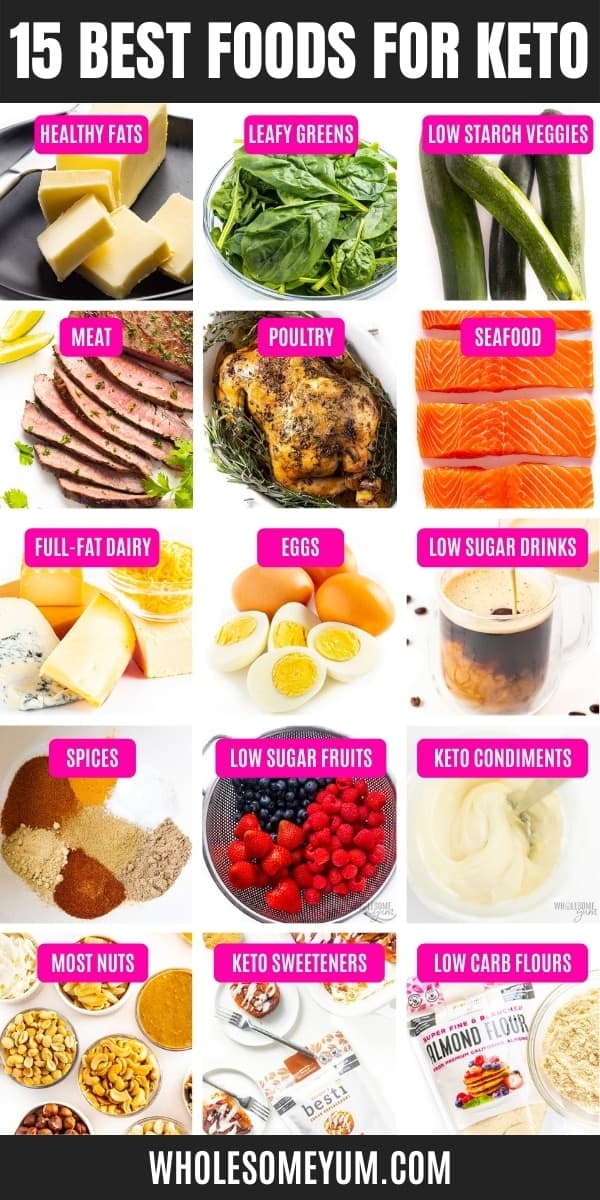
Foods to Avoid on a Low Carb Diet
Avoiding carbohydrates is probably the biggest adjustments for people starting a keto diet or low carb diet. Many of us were used to consuming carbs at every meal. Below is a list of foods to avoid:
- Grains – including wheat, bread, pasta, rice, oats, cereal, corn, etc.
- Sugar – including table sugar, candy, pastries, cakes, ice cream, chocolate, soda, juice, honey, maple syrup, etc.
- Starchy vegetables – including potatoes, sweet potatoes, parsnips, etc.
- Legumes – including beans, lentils, chickpeas, etc. (Peanuts are an exception in moderation.)
- High-sugar fruits – including bananas, pineapple, oranges, apples, grapes, etc.
- Low-fat dairy & milk – including all cow’s milk (except heavy cream is fine), low-fat cheese, etc.
- Seed & vegetable oils – especially margarine, canola oil, corn oil, grapeseed oil and soybean oil
- Processed “low carb” foods – this depends on ingredients, so read labels for hidden sugar, starch, and artificial ingredients
Get these out of your house if you can! If you have family members that are not on board, at least store these in a separate area from other foods to reduce temptation.
Also, always, always check labels for any food that has one. Avoid anything that has added sugar or starch as an ingredient, watching for different names like dextrose, maltodextrin, maple syrup, honey, corn syrup, cornstarch, potato flakes, etc. Sometimes you’ll be surprised where you might find added sugars.
Low Carb & Keto Diet Grocery List
The list above should give you an idea of the best and worst foods for a low carb diet. But if you’re starting out, it’s a good idea to know exactly what is included:
- Start with the complete low carb & keto food list – it has over 230 foods on it! It includes all the keto diet basics that you can and can’t eat, including carb counts. If you prefer to start with a shorter, less overwheming list, grab the keto grocery list for 1-2 trips to the store.
- Stock your pantry with all the dry keto basics and staples.
- Get discounts on keto products here – exclusive for Wholesome Yum readers!
- Check out the keto sweetener guide to help you choose the best ones and convert from one sweetener to another. You may or may not want to start with sweeteners right away, but it’s there when you’re ready.
- Buy keto ingredients here, including sweeteners, flours, syrups, baking mixes, and more.
Low Carb & Keto Recipes
If you are looking for low carb recipes or keto diet recipes, you’ve come to the right place! Every single recipe on Wholesome Yum is low carb and appropriate for the ketogenic diet.
Each recipe has 10 ingredients or less. I’m on a mission to show you that keto friendly recipes don’t have to be difficult, time consuming, or taste like “diet food”. I love sharing just how delicious and easy keto can be!
To get you started, here are a few of the most popular low carb keto recipes:
Another good place to start is with my library of keto dinner recipes, so you can start preparing ketogenic meals. The entire recipe index is at the button below.
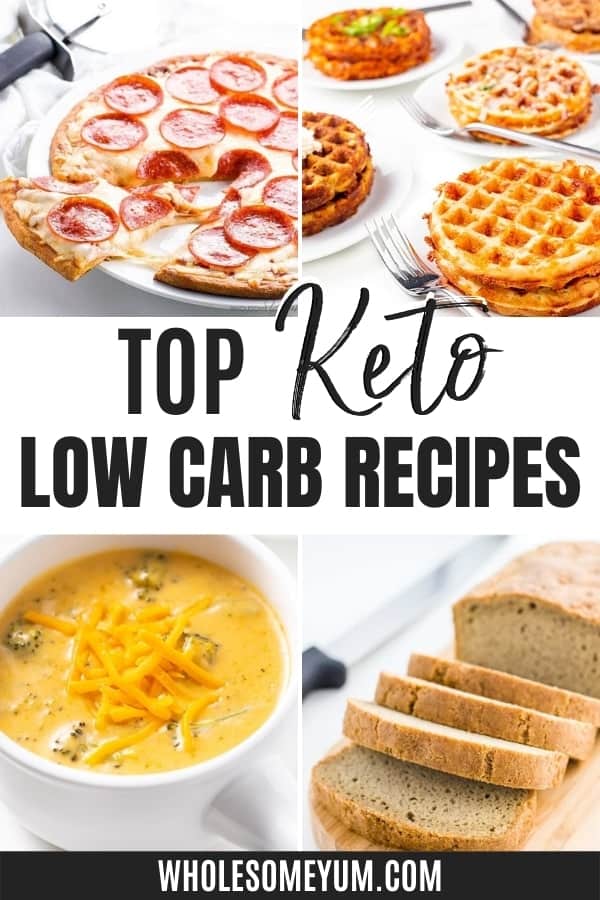
Keto Meal Plans
There are several excellent places where you can get a ketogenic meal plan:
- The Wholesome Yum App provides custom weekly keto meal plans that you can adjust to your preferences, builds an automatic grocery list for you, offers nearly 1,000 recipes, and has an easy macro tracker. Available on iPhone or Android.
- A FREE 7-Day Keto Meal Plan For Beginners is available right on my website. The recipes are simple keto diet basics that anyone can make.
- The Egg Fast Diet is a short-term ketogenic meal plan designed to break through a plateau on a keto diet.
- The Easy Keto Cookbook includes a sample week meal plan, plus 100 recipes for delicious ketogenic meals.
Get The Wholesome Yum App!
Make keto easy with customized keto meal plans, automatic macro tracking, auto generated grocery list, delicious low carb recipes, and more.
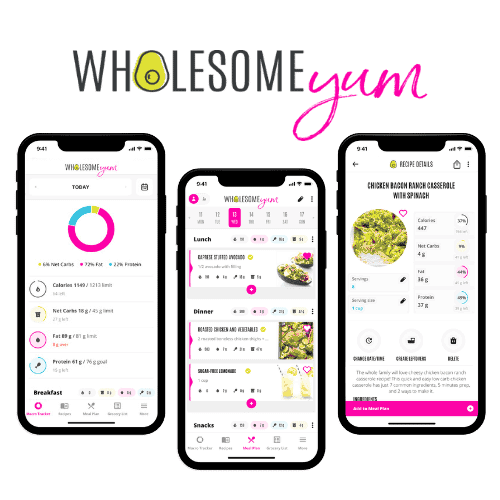
Get The Wholesome Yum App
Keto Diet Benefits
Following a ketogenic diet can have numerous benefits, including:
- Weight loss – Research shows that keto diets are more effective than low fat diets for long-term weight loss [*, *, *].
- Stable mood & energy levels – Reducing dietary carbohydrates is linked to better cognitive function [*, *] and possible reductions in depression and anxiety [*].
- Blood sugar control – Limiting carbs is shown to improve insulin sensitivity [*].
- Reduced cravings & appetite – Keto may positively affect your body’s hormones that signal hunger [*], and signal appetite suppression in the brain [*].
- Lower blood pressure – Some studies suggest that a low carb diet can be more effective at lowering blood pressure for obese patients than medication [*].
- Higher good cholesterol – In some studies, subjects following a keto diet experienced increases in HDL cholesterol levels [*].
- Skin improvements – Research suggests that keto can help improve skin conditions like acne, though more studies are needed [*].
- Digestive support – Some studies link keto with healthy gut bacteria [*].
- Possibly increased lifespan – Recent rodent studies show that a low carbohydrate diet improved longevity [*].
- Preservation of muscle mass – Loss of muscle is a common issue when losing weight, but a very low carbohydrate diet is more effective at preserving muscle mass compared to conventional diets [*].
Keto Diet Side Effects
Because a low carb diet (especially a keto diet plan!) reduces the amount of water you store, this can flush out electrolytes and make you feel sick — this is called the “keto flu”. These side effects of keto are temporary while you are adjusting to a ketogenic diet, but unpleasant. They can include headache, dizziness, fatigue, restlessness, brain fog, lack of motivation, nausea, insomnia, impaired coordination, sensitivity to heat, sugar cravings, muscle soreness or weakness, and stomach issues.
Fortunately, you can avoid or eliminate these side effects by salting your food liberally, drinking broth (especially bone broth), drinking my homemade electrolyte drink, and eating pickled vegetables. These keto diet basics are just as important as restricting carbs. Some people also choose to take supplements for electrolytes, but it’s best to first consult a doctor.
Check the complete guide to keto flu symptoms and remedies here so that you can avoid it!
Common Questions
- Is the keto diet healthy? If your keto diet is unbalanced, you may end up with deficiencies in electrolytes, B vitamins, iodine, iron, or other nutrients. However, a balanced keto diet with a focus on whole foods and healthy fats is a great, healthy choice.
- Is the keto diet safe? A keto diet is perfectly safe to try for generally healthy individuals. However, if you have any underlying health conditions, you should consult with a doctor before trying any new way of eating.
- Is the keto diet good for diabetics? Those with diabetes can benefit from a keto diet because it improves blood sugar and A1C levels [*]. However, it’s still important to work with a doctor when considering diet changes.
- How long does it take to enter ketosis? It usually takes about 3 days after starting a ketogenic diet to enter ketosis. However, it takes 3-4 weeks before you are “fat adapted” and burn fat efficiently. This is because the body takes a few days to burn through all the glycogen in your liver (your body stores extra glucose there and this gets depleted before you start producing ketones), and afterward, it takes some time for your body to adjust to using primarily fat for fuel.
- How to get enough fat on a keto diet? Eat foods naturally high in fat, such as eggs and fatty cuts of meat, or add dietary fats like grass fed butter and MCT oil to meals. You can also snack on fat bombs for a high-fat boost!
Conclusion: Is The Keto Diet For You?
The keto diet plan can be beneficial, enjoyable, and surprisingly easy to follow! But as always, always check with your doctor (preferably one that understands and supports a ketogenic lifestyle) before making a drastic change, especially if you take any medication. If you have the green light, use this guide for all the keto diet basics you need to get started.
How To Start A Keto Diet
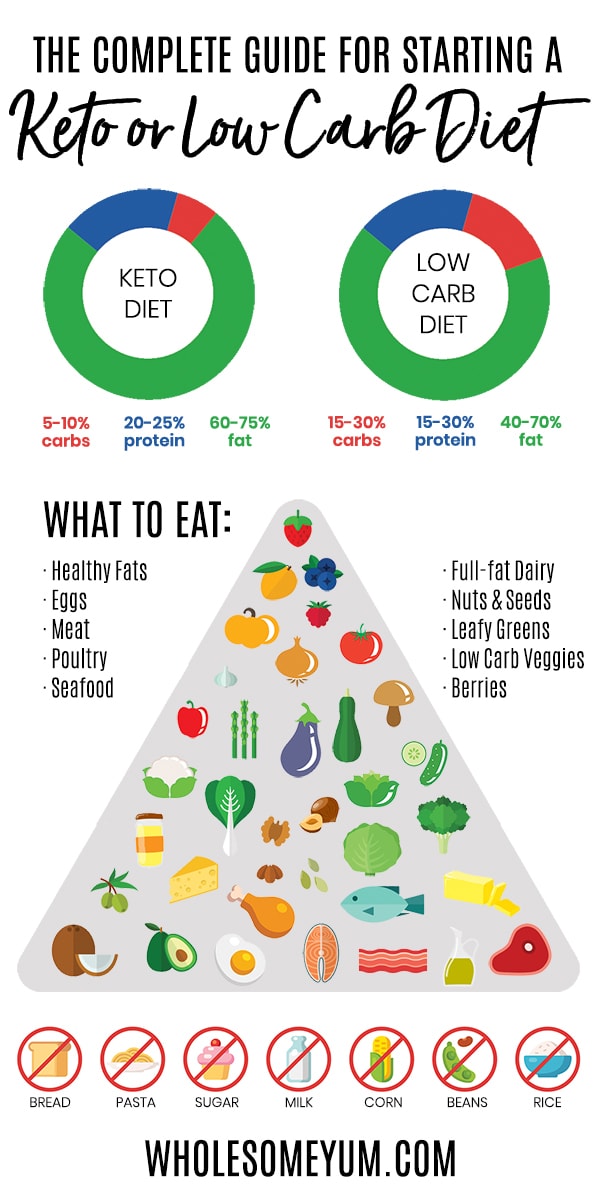
 My
My Shop
Shop Wholesome Yum
Wholesome Yum
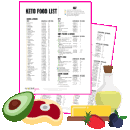
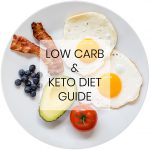

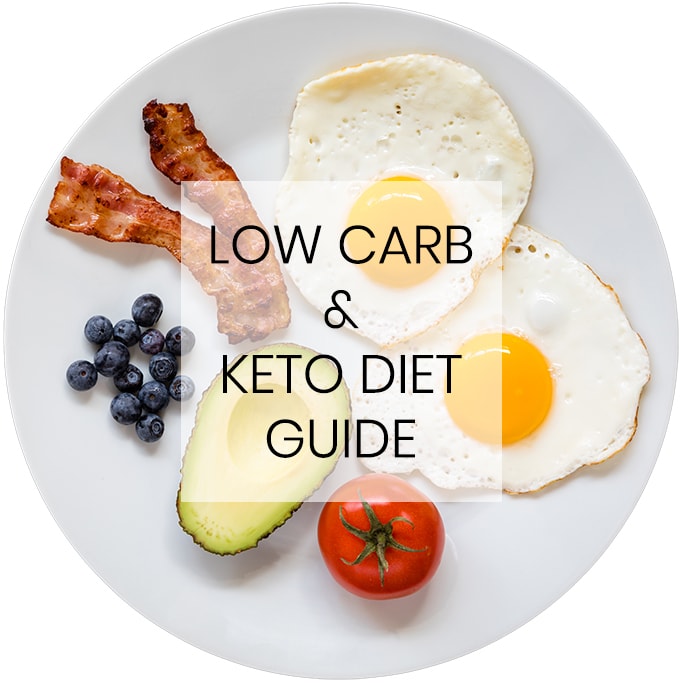





491 Comments
Ruth Hill
0Thank you. Very helpful in getting started!
Judy
0How much protein, a day, should one eat on a low carb diet? Thank you!
Wholesome Yum L
0Hi Judy, it can be different for each person depending on your age, height, weight, and activity level. I would suggest using our online Macro Calculator to give you more specific information that is tailored to you.
Monica
0I loved your information because I started a long time ago not to eat carbohydrates a little bit but this is good for me. The only thing I have a problem with is the breakfast I could eat. Thank you very much.
Yvonne warren
0Hi
I have been on the Keto plan for about two months and lost 17 pounds. However , I need to shed at least 10 more and I am stuck! Any suggestions?
Maya | Wholesome Yum
0Congrats on your progress, Yvonne! While I can’t offer 1-on-1 support here, I hope you’ll join our support group here for questions like this.
Maricar
0I’m a Keto Friendly Diet Beginner! Wish Me LUCK!
Maya | Wholesome Yum
0Best of luck!
Patricia
0Hi Maya,
Awesome website! So much great information and I am just starting.
Can you use any of the Easy Keto Low Carb Drink Recipes as a meal to replace maybe breakfast or lunch?
If not, do you have any suggestions? Sometimes it is easier to to drink breakfast or lunch and not ruin my daily low carb diet?
Maya | Wholesome Yum
0Thank you, Patricia! You could have a drink or smoothie for a meal if you’d like, but I find that usually it’s more satisfying to eat an actual meal, especially for lunch. Many people do include intermittent fasting in their keto diet, though.
Pat Blessing
0I have been on the Keto Diet plan for a month now. I know that I should not be concerned with the numbers on the scale BUT, my weight has only got down about 2 pounds?
I write down everything I eat, swim, walk and what else should I do to lose weight?
Help!
Maya | Wholesome Yum
0Hi Pat, There are so many factors that can affect weight loss, from what you’re eating to the amount you have to lose, among other things. While I cannot offer 1:1 support here, our support group is a great place for that.
Linda
0great website. I am so excited to start my new adventure and hopefully lose the weight.
Maya | Wholesome Yum
0Best of luck, Linda!
Klea
0Hey, I really love the idea of this diet but HOW MUCH of these foods am I meant to be eating? I guess I can’t just EAT fats all day, every day, waiting for the fat to fall off so how much of this stuff do I eat. Eat till I’m full? I really don’t know and hope you can help me.
Maya | Wholesome Yum
0Hi Klea, Check the macro calculator for how much you need.
Chris
0I’m really psyched to try this new dietary lifestyle!
Maya | Wholesome Yum
0Best of luck, Chris! Thanks for stopping by!
Sara
0Is it okay to use extracts, for instance vanilla or almond extract?
Maya | Wholesome Yum
0Hi Sara, Yes, absolutely! Just make sure it’s not something with sugar added.
Jinky Aquino
0Hi, I am so much overweight at 78 kg and really wanted to lose my desired weight 48-50 kg, but then I had an operation. If I go on keto, will that be good for me or will it not cause any complications? I am 42 and a single mom of 4. Kindly help me. Thanks a lot.
Maya | Wholesome Yum
0Hi Jinky, Thank you for visiting! Unfortunately I’m not able to give medical advice, so it’s best to consult your doctor about the effect of any diet on your health, especially when it comes to specific conditions or surgeries.
Jannett
0Thanks so much for your help, my husband and I are new to the Keto diet.
Maya | Wholesome Yum
0Best of luck to you and your husband, Jannett!
Thomasa Shadden
0Awesome site!
Maya | Wholesome Yum
0Thank you, Thomasa!
Carol
0Hi, how much is the subscription ?
Maya | Wholesome Yum
0Hi Carol, The newsletter subscription is free, and the members area is also free for all subscribers.
Bex
0It’s silly, but this page reads “metal” clarity at least twice. I think you meant “mental”.
Maya | Wholesome Yum
0Thank you for bringing it to my attention, Bex! It’s all fixed, thank you!
Janet
0I have signed up for everything and I am not receiving the confirmation email
Maya | Wholesome Yum
0Hi Janet, Please check your spam folder for an email from hello [AT] wholesomeyum.com. Otherwise, you can contact me here and I’d be happy to help.
Stacey
0Amazing! I am so looking forward to this as it’s all the stuff I normally eat anyway!
Maya | Wholesome Yum
0I am so hope you like it, Stacey! Thanks for stopping by! Have a nice day!
Mel
0Hi I’m new to Keto. I have been reading about it, and understanding what to eat and what not to eat. My problem is I’m not sure if I’m doing it correctly. I’m constantly hungry whereas information reads that I will never be hungry. I use fats as required along with topping up with vegetables in my meals yet this does not fill me up. I haven’t experienced the Keto flu and I’ve even put on weight! I have been doing this for about 3 weeks now. Any ideas where I am going wrong.
Maya | Wholesome Yum
0Hi Mel, Sorry to hear you are having issues with keto. There are many factors that could be the culprit, such as eating too many carbs, not enough fat, already being close to goal weight, and others. While I’m unable to offer 1:1 support here, I hope you’ll join our Facebook support group that can help you.
Stacey
0I would like to know what do I need to change on keto because I am diabetic and my doctor says I can’t go full blown keto diet, because of kidney problems. Can you help me?
Maya | Wholesome Yum
0Hi Stacey, I can’t give medical advice and definitely recommend following your doctor’s recommendations. You can ask him/her if low carb would be better suited for you. Also, you may want to double check with him/her if the kidney concern was related to high protein, because that is a common misconception about keto – it is not a high protein diet/lifestyle.
Wendy
0If I add garlic, onion powder and cilantro in batter, will it help with the dominant egg taste?
Maya | Wholesome Yum
0Hi Wendy, What recipe are you asking about? Is best to ask on that page.
Renan Freitas
0Your blog has helped me a lot. I am eternally grateful to you.
Maya | Wholesome Yum
0Thanks so much, Renan! Have a nice day! Please come back again soon!
Mea
0Hello Maya,
Thank you for your precious advice and sharing with us your delicious recipes.
I would like to start the Ketogenic diet and I am gathering necessary info. I have a question though… I have read many comments about “high carb” meal, day in a Keto regime.
Can you advise in regard to this, what is the best practice about these days?
Thank you,
Mea
Maya | Wholesome Yum
0Hi Mea, In general, I don’t recommend incorporating non-keto meals or a full non-keto day. It takes a few weeks of keto to get fat adapted, and non-keto meals just work against this. Some people do but it’s not my recommendation. If you miss certain foods, I have lots of recipes for low carb and keto equivalents of desserts, bread, pizza, etc.
Dar
0Hi, I have signed up a few times but don’t get the final email… can you please email it?
Maya | Wholesome Yum
0Hi Dar, Sorry to hear you’re having issues with the emails. Please contact me using this form and I’d be happy to help.
Babatunde
0I don’t know what is wrong, sorry
Barb Gunter
0Hi Maya, Thank You for accepting me. I have a question. I have been eating Keto faithfully for 3 weeks I have lost & gained every day. I can’t figure it out. A friend said I don’t have enough to lose, I need to lose 10 to 15 lbs. Could that be true? I think I need help please. Thanks, Barb
Maya | Wholesome Yum
0Hi Barb, That can definitely be it. Losing when you are close to goal can be more difficult. It could also be that your body’s healthy weight is a little higher than what you’d like – which doesn’t mean you can’t lose, but makes it more difficult. If just eating Keto foods isn’t working, double check the macros for your weight and see if the amount you’re eating needs to be adjusted. You’ll find more help and support in our support group here.
Patty G
0How do we get enough vitamin C and calcium on a keto or low carb meal plan? I love grapes and bing cherries and miss having them. I am post menopausal age and am concerned getting enough calcium. I do take calcium supplements.
Maya | Wholesome Yum
0Hi Patty, There are plenty of low carb vegetables you can eat that contain both vitamin C and calcium, and also many dairy products are also included in the plan. Check the low carb food list here. Supplements are great, too!
Judy & Cliff Harrington
0Hi Maya!
First, I want to thank you for all of your dedication and work in providing this site. The difficulty of maintaining a healthy weight is a big problem for so many people. My personal question & issue in staying on Keto is my craving for fresh fruit. This a.m I had a large fresh peach along with my “Bullet Proof” coffee. Have I now sabotaged today’s Keto eating?
Maya | Wholesome Yum
0You’re very welcome, Judy! I’m glad it’s helpful. If you are keto (as opposed to low carb), unfortunately peaches would not allow you to stay in ketosis. You can check my keto food list to help determine what is keto friendly. Of course, there are worse things than fresh fruit 🙂 but in the end our bodies still see the sugar. That being said, it doesn’t mean you sabotaged the whole day. Just pick up again – you got this!! (And for next time, try some fresh berries in moderation when you’re craving fruit.)
Kelly
0I am new. How do I count the macros for foods? Like salmon… where would I find this? Or avocado. Or even the carbs. Where on the label? Or no label?
Maya | Wholesome Yum
0Hi Kelly, All packaged foods will have a nutrition label that list the macros per serving, including fat, protein and cabrohydrates. Net carbs, which is what most people look at for low carb and keto, are total carbs (the amount on the label) minus fiber, erythritol, and allulose, as explained in the article above. I have a low carb food list here that gives you a full list of all the foods you can eat, and the net carbs in each. You can also sign up above to be notified about the meal plans, which are a great way to get started.
Maelynn
0Hello Maya,
My Husband and I started doing Keto July 2018. We got over weight after we got out of the Marine Corps. It has been hard to workout because I became disabled, but my diet was not good. After our friend Amber recommended your site and support group, we found a lot of helpful information to get us started on a successful journey. So far it’s been one month and we have lost 18 pounds each!
I have tried to get ahold of you. If you could answer me back. It will really help us out still on our mission.
Maya | Wholesome Yum
0Thanks for sharing your story, Maelynn! I’m so glad you and your husband find the site helpful. If you need to contact me, you can do so using the contact form in the navigation menu.
Deb
0I have recently had fundoplication surgery. Is it ok for me to try this diet?
Maya | Wholesome Yum
0Hi Deb, While I don’t see any reason not to, I am not able to give medical advice. I recommend checking with a doctor that knows your health situation and also understands low carb/keto well enough to advise on it.
Lisa
0Hi. I Don’t know if you can help, but I am having a difficult time finding the right Macro online calculator that works. Each one I’ve tried gives me a huge variance in calories & carbs, proteins and fats. Please can you suggest an accurate one to use?
Maya | Wholesome Yum
0Hi Lisa, Yes, I have a macro calculator here that is accurate.
Sue
0Hi Maya, I love your site. I’m finding that I have more trouble keeping my protein macros below max than I do with the carbs. Do you have many recipes that are low carb and low protein that are entrees? Do you have suggestions on keeping protein low, besides cutting out meats?
Maya | Wholesome Yum
0Thank you so much, Sue! The nutrition info is listed for each recipe on the site. Cooking with more fat would balance the macros more toward the fat side. If you need additional support or have more questions, I hope you’ll join us in our Facebook support group!
Evett
0I hope this site will help me to lose weight.
Gigi
0Hi, I’m still a bit skeptical, I have seen some of my friends do the keto diet, and have had good results. Though I am still not sure about the idea of the fats being eaten. They say they eat meat with the fat and must do so, is this correct? Also isn’t this not good for the body especially for the kidneys? Second, can a diabetic do this diet? There are many questions running through my head.
Maya | Wholesome Yum
0Hi Gigi, Low carb and keto is about the balance of macronutrients eaten (fat, protein and carbs), not specifically meat or lack thereof. Most people on keto do eat meat, though some people do vegetarian keto. Fat is actually necessary for many body processes. There is no issue for the kidneys with a high fat diet, but if you eat too much protein that isn’t great for the kidneys. It’s a common misconception that keto is high protein (it isn’t). Keto is great for diabetics as it naturally helps stabilize insulin. All of this being said, please know I’m not a doctor and you should consult your doctor on any medical questions or before starting any diet. If you have more questions that aren’t medical questions, I recommend our low carb & keto support group here.
Conny Fuller
0Question: I did not see any portion limits. When I make a keto pizza what is my portion limit?
Maya | Wholesome Yum
0Hi Conny, This will vary depending on so many factors, like your weight, gender, activity level, whether you are doing low carb vs keto, what else you ate that day, etc. While I cannot offer 1:1 support here, you can join our Facebook support group and that’s a great place to ask questions like this!
Helen Strawson
0Hi Maya. I LOVE your site!! Interesting, informative with fab recipes and ideas. Hubby and I have just started eating low carb and I have to say, we are not finding it too difficult and I already feel sooo much better!! I find the hardest part is choosing low carb veg, I feel as if we are not eating enough. Any suggestions on how to get more veggies into our diet?
Thank you for all the hard work you put into this
Maya | Wholesome Yum
0Thank you, Helen! I’m glad it’s helpful. Here is a full low carb food list that has lots of veggie options. You might also like the low carb side dishes recipe index, which is essentially all vegetables.
Mel
0Can we have as much ranch dressing we want?
Maya | Wholesome Yum
0Hi Mel, Assuming that your ranch dressing doesn’t have sugar added, you don’t need to worry too much about limiting it, but within reason. This is my homemade ranch dressing recipe, which has 0.9g net carbs per 2-tbsp serving. It would be hard to find a store bought one with much less than that, even though some round anything less than 1g down to 0g, which isn’t truly accurate. Also, keep in mind that if weight loss is your goal, some people find that too much dairy can cause a stall. Finally, make sure you aren’t using all your “available” carbs on ranch dressing – have it with some low carb veggies!
Carla
0What do you think about taking collagen ? Good or bad.
Maya | Wholesome Yum
0Hi Carla, Definitely good! I wrote a whole guide about collagen here.
Carla
0Thank you. Great info.
Kim
0Thank you so much Maya !
Genger
0Fantastic! thank you!
Tammy
0Maya – I love your articles, your recipes and your suggestions on where to find items. I have made quite a few dishes and my husband loves them. Also, you have taken the guess work out of where to find specific items. I hope you continue to give us your gift of time and recipes.
Maya | Wholesome Yum
0Thank you so much, Tammy! I’m glad you and your husband like the recipes.
Ostine Watts
0Love your website and recipes!!!!!!
Maya | Wholesome Yum
0Thank you, Ostine!
Waed
0Thank you so much for this amazing info. I breastfeed and I want to start a low carb keto, but I don’t know how and when to start every meal.
Greg Mansker
0Very informative! Just starting my low-carb diet. Can’t wait to shed some pounds!
Gloria lockyer
0Well, I am going to give this another try. I have great difficulty in eating greens , or drinking them, also I am not fond of fats, years and years of low fat diets have totally screwed my metabolism,and taste buds. I will read this page every day to keep my mind focused. Start tomorrow when I get up …… I work nights which can cause me problems as well. When I tried this diet before, I got terrible cramp, now I realise I wasn’t drinking enough water. Anyway.here goes.
Maya | Wholesome Yum
0Best of luck, Gloria! Make sure you’re getting enough electrolytes too, if you were experiencing cramping.
Cyn
0It’s my understanding that keto is up to 50 grams of net carbs, not only 20 or 30. That generally it’s recommended to eat 25 or less, but that some people can go higher and still be on “keto” as long as they stay below 50.
Maya | Wholesome Yum
0Hi Cyn, The numbers are general guidelines but will vary depending on many factors, such as activity level, insulin resistance, weight and more. There is no single magic number, just conventional recommendations that are a good starting point. I will have a macro calculator coming soon that will help determine what is best for each person, but even then it’s an approximation. The only way to know for sure is to test. If keto is your goal, it’s usually best to start lower and then see if you can stay in ketosis when increasing.
Cyn
0Yeah, that’s what I did in the beginning – started lower (trying to keep it below 25), but I eventually bumped my limit up to 35 and it’s been working well.
Dyan Bailey
0Maya,
Will your weekly meal plans be available for Keto soon? Also, if someone is on a much lower calorie count will the plan be adjustable for that? Ex. I’m only allowed 1043 Cal’s and 14 carbs.
Thanks,
Dyan
Maya | Wholesome Yum
0Hi Dyan, Yes, the weekly plans will be available soon! If you sign up using the form at the bottom of the article, you’ll be the first to know when they are ready. There will be some flexibility to adjust for your macros.
Cathy
0This is really helpful, especially the Keto diet pyramid infographic. It will be easy to explain to skeptics by showing them this guide.
Maya | Wholesome Yum
0Thank you, Cathy! I’m so glad to hear that.
Maria teresa
0Very interesting, thank you.
Jane Gapinski
0Thanks for clarifying the Keto diet. Since I started back in March 2018 my doctor is impressed with my blood work. A1C dropped 3 points, please keep the recipes coming.
Maya | Wholesome Yum
0That’s fantastic, Jane! Keep it up!